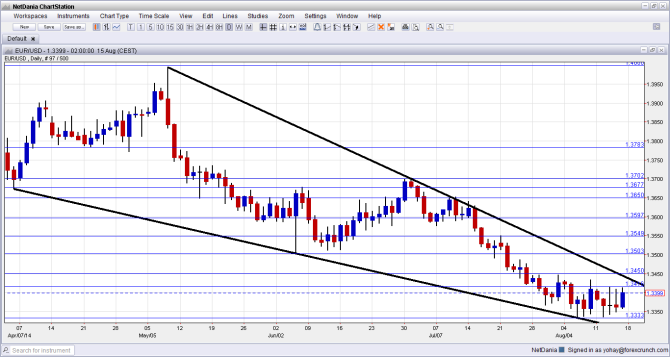EUR/USD saw a new slide once again. but did not really make a substantial move. The focus is on the PMIs and on Mario Draghi speech in Jackson Hole. Here is an outlook on the highlights of this week and an updated technical analysis for EUR/USD.
The Eurozone releases showed a stall in the euro area recovery with poor economic climate and sluggish growth in the second quarter. Germany’s ZEW economic sentiment plunged to 8.6 points from 27.1 in July, well below market forecast of 18.2 points, and the Current condition index fell to 44.3, indicating geopolitical tensions halt expansion in Germany. Furthermore, the Eurozone economies fail to generate real growth. Germany, the leading force in the euro area contracted 0.2% in the second quarter, according to preliminary GDP estimates, the first contraction in the German economy since Q4 of 2012. Likewise France economy remained flat form the first quarter. Will this trend continue?
[do action=”autoupdate” tag=”EURUSDUpdate”/]EUR/USD daily graph with support and resistance lines on it. Click to enlarge:
- Trade Balance: Monday, 9:00. The euro zone’s trade surplus widened less-than-expected in May, reaching €15.3 billion from a surplus of €15.2 billion in April. Exports climbed to €160.5 billion in May, from €159.6 billion in April, and imports increased to €145.2 billion, from €144.4 billion in the preceding month. On an unadjusted basis, the surplus remained at EUR 15.4 billion. The trade surplus is expected to narrow to14.98 billion.
- Current Account: Tuesday, 8:00. The Eurozone current account surplus declined in May to a seasonally adjusted EUR 19.5 billion from EUR 21.6 billion in April. The surplus products declined to EUR 13.8 billion from EUR 16.9 billion in the previous month. Meanwhile, the surplus on services edged up to EUR 13 billion from EUR 10 billion. Income narrowed sharply to EUR 1.7 billion from EUR 5.4 billion. However, the deficit in current transfers narrowed to EUR 8.9 billion from EUR 10.7 billion. The Eurozone current account surplus is expected to widen to 21.3 billion this time.
- German PPI: Wednesday, 6:00. German producer prices dropped again in June, however at a slower pace. Producer prices declined 0.7%, following 0.8% drop in May, in line with market forecast. Energy prices continued to fall, dropping 2.4% in June. While, prices of commodities edged up 1.3% and prices of consumer goods and capital goods increased 0.9% and 0.5%, respectively. On a monthly base, producer prices remained unchanged in June, after the 0.2% fall in May. German producer prices are forecasted to rise 0.1%.
- Manufacturing and Services PMIs: Thursday. The Eurozone’s economic recovery rebounded slowly in July, driven by Germany and the services sector. However the crisis in Ukraine is a big concern for companies, making it hard to commit to new purchases, investment and hiring. The Eurozone services sector expanded to 54.4 from 52.8, reaching its highest level in more than three years. However, despite the rebound in services the sector, companies did not expand their workforces, while continuing to cut their selling prices. Meanwhile the euro area manufacturing sector inched higher to 51.9 from 51.8 in June. Germany continued to strengthen with a sharp expansion in the services sector, rising at the fastest pace in more than three years, reaching 56.6, gaining 2 points from June. However the Ukraine situation poses a major risk on future prospects. German manufacturing also improved, rising to 52.9 form 52 in the prior month. France remained the weak link among the largest economies in the euro area. Private-sector activity in July rose to 50.4 from 48.2 in June, reaching expansion. But the manufacturing PMI fell to 47.6 from 48.2 to reach a seven-month low. Except for the rise in the Eurozone’s services sector, the general tone continued to be gloomy, with new orders falling for the fourth straight month, while employment fell for the ninth straight month. French Manufacturing is expected to improve to 47.9, while services is expected to reach 50.3, German Manufacturing is expected to drop to 51.8, and Services to 55.5, Eurozone Manufacturing is expected to decline to 51.4, and Services to 53.6.
- Consumer Confidence: Thursday, 14:00. Consumer sentiment in the euro zone plunged below expectations in July, falling to -8.4 from a revised -7.5 in June. Analysts expected the index to rise to -6. The sharp decline raises concerns over the Euro-area’s economic recovery. The chief concern is the conflict in eastern Ukraine, where separatists backed by Russia are fighting government forces. As a result the Eurozone considers imposing economic sanctions on Russia, a leading economy in the Europe. Such measures could endanger the euro zone economic recovery. A Consumer sentiment is expected to drop further to -9.
- Mario Draghi speaks: Friday, 18:30. European Central Bank head Mario Draghi will follow Federal Reserve Chair Janet Yellen’s speech at the Jackson Hole Symposium and talk about employment issues. Market volatility is expected especially as the new data, especially GDP is certainly worrying. Could Draghi up the ante on the chance of QE?
* All times are GMT
EUR/USD Technical Analysis
Euro/dollar started the week with a slide and bounced off the previous lows, just above support at 1.3325 (mentioned last week). It then traded in range and closed the week just slightly lower.
Live chart of EUR/USD: [do action=”tradingviews” pair=”EURUSD” interval=”60″/]
Technical lines from top to bottom:
The round number of 1.37, is another support line after capping the pair in December yet it is weakening. 1.3677 was the peak in June so far, and could turn into important resistance.
1.3650 worked as strong resistance during May and June but is weakening now. 1.3585 served as the bottom of the range and still carries weight despite the breakdown in June. 1.3550 worked as support in January but is now weakening.
The round number of 1.35 worked as the last cushion in June and is strong also due to the roundness. 1.3450 worked as resistance in August 2013 and as support in September and October. It is now a key line on the upside.
The 1.3415 level managed to cap the pair in August and serves as a barrier before 1.3450. Below, the next line of support is only at 1.3333, a level that worked as a cushion to the pair during August and just above 1.3325 that separated ranges back in September 2013.
1.3295 is the next line: it was the low level in November. Below this line the round number of 1.32 is the important due to its role in August 2013.
Even lower, 1.3250 was a stepping stone for the pair when it was on its way up in 2013. The last line for now is 1.3175.
Narrowing downtrend channel
As the thick black lines on the chart show, the pair is trading within two downtrend lines in recent months. Downtrend resistance, that begins from the near 1.40 peak and was mentioned here before is quite far from the line at the moment. Downtrend support accompanies the pair from May and was formed in June. The pair is in the upper part of the channel.
I remain bearish on EUR/USD
The divergence in economic performance between the steadily growing United States (despite some bumps) and the very fragile recovery in the euro-zone continues. This goes hand in hand with monetary policy that is also going in separate directions. The forward looking PMIs could now point continued weakness in the euro-zone also in the months ahead.
More EUR/USD: Forex Analysis: EUR/USD Stalls within Strong Bearish Trend
Further reading:
- For a broad view of all the week’s major events worldwide, read the USD outlook.
- For the Japanese yen, read the USD/JPY forecast.
- For GBP/USD (cable), look into the British Pound forecast.
- For the Australian dollar (Aussie), check out the AUD to USD forecast.
- USD/CAD (loonie), check out the Canadian dollar forecast
- For the kiwi, see the NZDUSD forecast.

